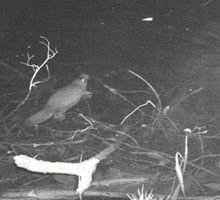Marine and Freshwater Research
Volume 76
Number 8 2025
Time-lapse cameras were used to describe how platypus activity patterns changed during a cease-to-flow event lasting nearly 2 months along a normally reliably flowing Tasmanian stream. The findings indicate that the platypus’s ability to survive extended dry periods relies on its having access to sufficiently large and productive refuge habitats. (Photograph by Simon Roberts.)
Historical records can provide invaluable insights into long-term changes in marine communities, but they are limited by the methods used at the time. In this study, we have highlighted how the marine life at a popular site in Sydney has changed over 58 years, owing to the efforts of citizen scientists. (Image credit: Jordana Costa.)
This study examined how pollution affects the diversity and nitrogen content of macroinvertebrate communities in Chile’s Maipo River Basin. Organisms of polluted areas have higher nitrogen concentrations, likely owing to nutrient input. This could have an impact on the macroinvertebrate diet, affecting the community composition, functional feeding group diversity and the trophic structure, which should be considered for futures management plans.







